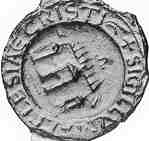
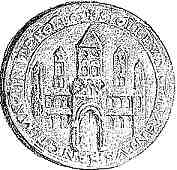
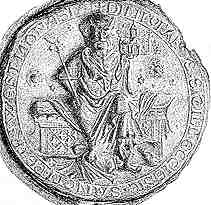
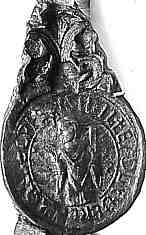
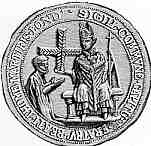
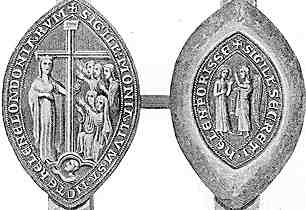
If you are looking at this page without frames, there is more information about medieval writing to be found by going to the home page (framed) or the site map (no frames).
| Seals of Ecclesiastical Institutions | |||||
| The church was learned and literate and conducted its business using the literate processes of the time. These required the use of a seal. Individual clerics possessed both seals of office and also personal seals, but the institutions which they served also had their own seals for ratification of documents significant to them as institutions. Possession of such a common seal became compulsory for religious houses at the beginning of the 14th century. These seals could display a diversity of designs, sometimes almost in the form of pictorial narrative. There seems to be more variety and freedom in institutional seals than in those of individuals. | |||||
 |
At left, the seal of Christ Church, Canterbury, from a chirograph of 1152 (British Library, Campbell Charter xxii 2). (From Warner and Ellis 1903) At right, the second seal of Battle Abbey. |
 |
|||
| Seals could depict the actual buildings of the religious establishment. Given that major medieval church buildings were rebuilt and modernised many times, this may give some insight into the architectural history, depending on the detail and precision of the design. Given that there is nothing left today of Battle Abbey but the late medieval gatehouse, the example above gives a tantalising hint of the abbey church building. | |||||
 |
The building might be included in a more elaborate composition, held symbolically by the founder or patron saint. In this example, St Peter sits enthroned and holds a model of the church in his left hand. | ||||
| Reverse of the second seal of Westminster Abbey. | |||||
| Founders and patrons could feature in various kinds of designs. This example is unusual in that is probably represents the adoption by the abbey of the personal seal of a founder as its institutional seal. This seal is attached to a 13th century charter, but the seal matrix is believed to date from the 10th century and is the personal seal of Edith, who refounded and rebuilt the nunnery and may have been its abbess. The design features Edith with one hand raised in benediction. |
 |
||||
| Seal of Wilton Abbey from a 13th century charter (British Library, Harleian Charter 45 A36). By permission of the British Library. | |||||
 |
The Hospital of St Thomas of Acon in London was founded by the sister of Thomas Becket after his death, using the family estates to endow it. The seal shows a figure kneeling below the enthroned figure of the saint and martyr, attired in the vestments of an archbishop and holding a large cross. | ||||
| Seal of the Hospital of St Thomas of Acon. | |||||
 |
Seal and counterseal of St Helen's nunnery in London. | ||||
| In the above example, the seal depicts the story of the patron saint. St Helen, the mother of the Emperor Constantine, who supposedly discovered the True Cross; the actual cross on which Christ was crucified. Bits of it subsequently appeared as sacred relics all over Christendom. The seal shows St Helen displaying the cross to the sisters of the nunnery. She holds the three nails from the cross in her left hand. The counterseal shows a depiction of the Annunciation. It is derived from the less formal seal, labelled SIGILE SECRETI, meaning secret or privy seal. The concept of a privy seal was not restricted to the royal chancery. | |||||
|
|
|||||
|
|
|||||
|
If you are looking at this page without frames, there is more information about medieval writing to be found by going to the home page (framed) or the site map (no frames). |
|||||